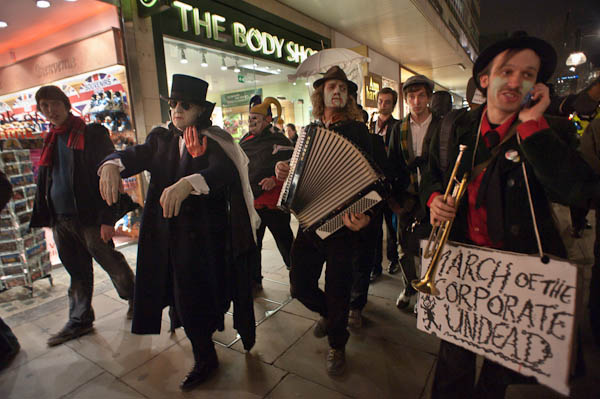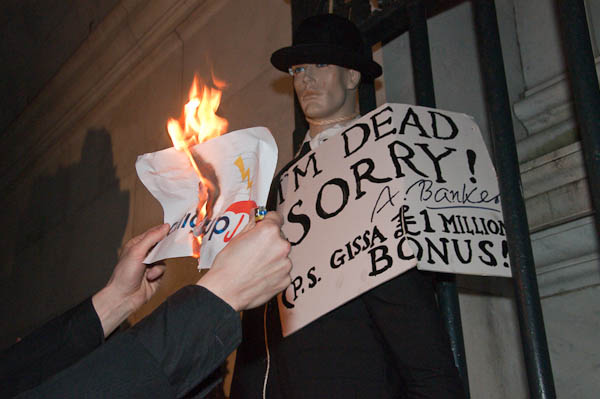I still don’t believe that in the longer term we need 36s24mm sensors and the rather large and clunky DSLRs that these entail, but for the moment at least, cameras like the Nikon D700 do offer considerable advantages when working in low light, and I had a good opportunity to exploit this on Tuesday.

The Body Shop, Oxford St
It isn’t hard to take pictures at night with digital cameras, but available light action shots such as this, even lit by the relatively bright lights of Oxford St are beyond DX format cameras such as the Nikon D2oo – on which I was also shooting, but with flash.
Interestingly, my tiny Panasonic camcorder, with its minuscule sensor, also did pretty well under these light conditions. Of course the image format is smaller, but it does make me wonder whether we are getting as much as we should from DSLRs.
I liked the idea of the troupe of zombies staggering past ‘The Body Shop‘ in their March of the Corporate Undead, but without half a dozen flash heads and a team of assistants, there just wasn’t enough light to get a usable result with the D200. Above ISO1600 it really struggles. This picture was taken at ISO 2000, 1/80 f3.5 and would have been a little better if I’d used ISO 3200 and stopped down for a little more depth of field, as the lettering and figure at the extreme right is just slightly out of focus.
Some of the action, particularly the hanging of the dead banker at Tyburn (Marble Arch) was a little too dark even for ISO 3200 and flash became essential. When one of the protesters set fire to sheet of paper and threatened to burn the dead bankerI was a little worried the flash might blot out the flames, but the results were fine.

Although I put in the stuff about speeds and apertures, most of the time when working I simply leave it to the camera and flash, which have all these automatic things that generally handle the technical stuff better than me. Of course you do sometimes have to give them a hand, often by dialling in a little exposure compensation, or altering the shutter speed or aperture and letting the camera’s smart program setting make the necessary compensation.
One thing I find handy at times when I shooting – particularly at the start of each event – is to take an exposure reading from a typical subject and then make appropriate settings for the camera’s manual, shutter priority and aperture priority modes. It helps if you do decide you need to switch to manual not to have to spend 20 seconds twidding the shutter speed dial from when you last used it for a long time exposure. It helps even more when (as I often do) you press the wrong button and change mode when you meant to dial in a little exposure compensation.
This pancake day event got a little publicity – even in the Evening Standard, and some fairly silly comments by one blogger about it possibly scaring children. Who would get my vote for twit of the week, if there hadn’t been an even greater idiot at the event who kept on standing in front of photographers and getting in the picture. And yes, of course, he was holding a compact camera.